Basic Information
Course Location: Shoaff Park
Geographic Location: north side of Fort Wayne, IN (41.14008, -85.09643)
Date Visited: October 2022
Number of Holes: 24
Course Length: 6412/7862 feet, par 72/76
Cost to Play: free
Difficulty Level: recreational, medium
Difficulty Level: recreational, medium
Carts: should be fine here
Potential to Lose Discs: very low except on the 6 lettered holes, which are medium due to dense woods
DG Course Review Page: https://www.dgcoursereview.com/course.php?id=163
Course Walkabout Video, Front 8:
Course Walkabout Video, Middle/Lettered 6:
Course Walkabout Video, Back 10:
Driving Directions: On the north side of Fort Wayne, take I-469 to Maplecrest Road (exit 29B). Exit and go south on Maplecrest Rd. Drive Maplecrest Rd. south 0.9 miles to Rothman Road and turn right on Rothman Rd. Drive Rothman Rd. west 0.9 miles to St. Joe Road and turn left on St. Joe Rd. Drive St. Joe Rd. south 1.1 miles to the signed main entrance for Shoaff Park. Turn right to enter the park, then immediately turn left. Drive this park road 0.3 miles to the signed parking lot for the disc golf course and Conklin Pavilion on the right. Park here; #1 tee is behind the right side of the pavilion.
Course Constructions:
Tees: concrete, 2 per hole
Baskets: 1 per hole, older but in good shape on my visit
Signage: course map at information kiosk, hole sign on each tee
Amenities: some benches, picnic tables, picnic pavilion, other amenities elsewhere in the park
Summary Review: 3 Stars (out of 5)
Built in 1985, the disc golf course at Shoaff Park has held up better than many courses from that era. The course's 24 holes consist of 18 original holes that play through an open to lightly wooded mowed-grass area and 6 new holes that play through a heavily wooded area. The original holes are numbered 1 through 18, while the new holes are lettered A through F. Based on the way the course is laid out, the easiest way to play all 24 holes is to play the first 8 original holes, then play the 6 new holes, then play the last 10 original holes. I have used that order in this review and in the course walkabout videos.
Because a couple of the original holes play around the wooded area, the 24 holes blend into a single course better than most courses that have a wooded "add-on." Of course the wooded new holes tend to be shorter than the open original holes. The entire course is laid out in a beautiful park-like setting. Due to the open nature of the course, wind can be a factor here. Although the gently rolling terrain is used to good effect, some of the original holes are too open and have only the terrain as a defense. As such, skilled players will not find this course to their liking. There are two sets of tees: the "short" red tees and the "long" blue tees. Almost inexplicably, the short tees are actually located behind the long tees on a couple of holes, which makes no sense to me. This course receives heavy use: there were about 7 groups playing here when I came here on a nice Sunday afternoon in mid-October. The course maintenance was near-perfect when I came here. The course route can be confusing with several tees or baskets in a small area, especially the area behind Conklin Pavilion. Thus, I recommend taking a picture of the course map on the information kiosk for reference during your round. I know I had to reference it a couple of times. Overall, Shoaff Park offers a pleasant round as a solid recreational course, but the routing issues and overly open landscape keep it from being a highly rated course.
Hole-by-Hole Review
Distances taken from course map and hole signs; red tee distance given first. Picture sequence for each hole is 1) red tee, 2) approach, 3) basket to tee.
Hole #1: 346/291 feet, par 3
Comments: we start with one of the weird holes where the red "short" tee is longer than the blue "long" tee. A row of large trees stands in front of both tees, and throwing through it is like throwing through a giant picket fence. The white line that crosses the fairway is a cross country running route; it is not part of the disc golf course. The basket is located on the back side of a small ridge, which makes putting more interesting. #2 tee is behind the basket near the road; look for the low concrete block wall.
Hole #2: 212/263 feet, par 3
Comments: a completely open hole except for a large sycamore tree guarding the front right side of the basket. As with #1, the basket is perched on the back side of a small ridge. #3 tee is behind the basket.
Hole #3: 262/301 feet, par 3
Comments: slightly uphill, now a small cluster of large trees stands between the tee and the basket. I would probably try to keep my disc low and curve it in from the left, but other options exist. #4 tee is downhill to the right and back toward #3 tee.
Hole #4: 325/337 feet, par 3
Comments: this hole continues the gradual uphill climb begun on the previous hole. 4 large sycamore trees guard the right side of the hole, and a few other large trees dot other areas. There are no trees in the immediate area of the basket. #5 tee is downhill to the right.
Hole #5: 303/362 feet, par 3
Comments: kind of the opposite of the two previous holes, a tight cluster of large trees combine with a mandatory (mando) on the right to force you to keep your disc low. The hole plays gradually downhill. There are no trees in the immediate area of the basket. #6 tee is to the left near the playground.
Hole #6: 235/272 feet, par 3
Comments: a mando on the right forces you to throw uphill on a tight line between clusters of large trees. Another tight gap between large trees stands just in front of the basket. I like the tightness of this hole even though some of the tightness is contrived. #7 tee is to the right beside the picnic table.
Hole #7: 240/290 feet, par 3
Comments: a sharp dogleg left, this hole starts in the open area, but the basket sits about 50 feet into the woods. The dense woods discourages you from cutting the dogleg and makes your angle of approach to the basket paramount. This is the only time the original course enters the woods. #8 red tee is back out of the woods about 50 feet from #7 tee; #8 blue tee is deeper in the woods down a path to the left.
Hole #8: 269/287 feet, par 3
Comments: my favorite hole on this course. The hole plays as two completely different holes depending on which tee you use. From the red tee, the hole is a sharp dogleg right with dense woods guarding the inside of the dogleg and a couple of large trees along the fairway to negotiate. From the blue tee, you throw uphill out a long, tight chute to an open area around the basket. The blue tee is a decent bit harder here even though it is not much longer. Hole A tee is in the woods to the right. If you want to skip the middle/alphabet 6 (as some players do), #9 tee is to the left.
Hole A: 224/275 feet, par 3
Comments: now the character of the course completely changes as you begin the middle/alphabet 6. Gone is the open mowed-grass area dotted with large trees; arrived are tight lines with dense woods on either side. This hole is slightly downhill, and an accurate throw will be necessary to get through the trees. Hole B tee is to the left.
Hole B: 211/267 feet, par 3
Comments: a copy of Hole A except it plays slightly uphill and in the opposite direction. Hole C tee is to the right.
Hole C: 276/416 feet, par 3/4
Comments: the longest and hardest hole on the alphabet 6, and possibly the hardest hole on the entire course. In addition to the dense woods that are everywhere, one large tree stands on either side of the fairway. Also, the basket is slightly in the woods to the right, not in the middle of the fairway. Hole D tee is to the left.
Hole D: 191/178 feet, par 3
Comments: a sweeping dogleg left that plays slightly uphill. This feels like the tightest hole on the course, so accuracy is paramount. Hole E tee is the left.
Comments: a flat hole with a large number of small trees near the line of play. An accurate throw is required, but nothing makes this hole stand out from the others on the alphabet 6. #9 tee is behind the basket out in the open area.
Hole #9: 207/321 feet, par 3
Comments: now the course leaves the woods and re-enters the open mowed-grass area for good. This hole plays slightly uphill with a couple of large trees standing between the tee and the basket. No trees stand in the immediate area of the basket. #10 tee is to the right.
Hole #10: 364/590 feet, par 3/4
Comments: a long but completely open hole with a couple of large trees to the left. No obstacles stand directly between the tee and the basket. #11 tee is to the right and beside the road.
Hole #11: 278/256 feet, par 3
Comments: a mostly open hole except for a cluster of large trees directly in front of the basket. I would choose to keep my disc low and go under the trees. The road is only about 30 feet to the left, and the road and points across the road are out-of-bounds (OB). #12 tee is behind the basket.
Hole #12: 242/207 feet, par 3
Comments: a very open hole with a single large tree to the right and a single large tree directly in front of the basket. The road to the left is again OB. #13 tee is to the right.
Hole #13: 256/347 feet, par 3
Comments: a mostly open hole except for a couple of small trees near the basket. A mando less than 50 feet from the tee forces you to keep your disc to the left. This mando feels contrived to me, and I think this hole would be better and give the player more options without the mando. #14 tee is behind the basket.
Hole #14: 290/315 feet, par 3
Comments: an almost completely open and boring hole except for two small trees near the basket. #15 tee is to the right.
Hole #15: 416/317 feet, par 3
Comments: similar in spirit to #14 but longer and playing the opposite direction. If the wind is up, one of these holes will play short and the other will be a bear. Also, this is one of the weird holes with the blue tee directly in front of the red tee. #16 tee is to the left.
Hole #16: 390/687 feet, par 3/4
Comments: another long and very open hole. The basket sits under a large tree, so you need to bring your disc in low or from the left. #17 red tee is to the right; #17 blue tee is to the left.
Hole #17: 287/510 feet, par 3/4
Comments: a completely open downhill hole except for a cluster of small trees near the basket. The lack of obstacles on these last 10 holes gets rather boring at this point, if it has not already. #18 tee is to the left.
Hole #18: 236/257 feet, par 3
Comments: a mostly open uphill hole. The basket is directly behind a cluster of medium sized trees. Unfortunately, the first 8 holes have more obstacles and keep the player's interest better than the last 10. The parking lot is about 400 feet to the left, behind the pavilion.






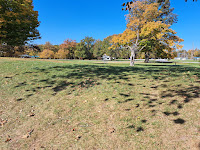







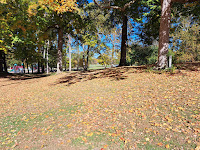


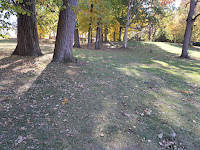















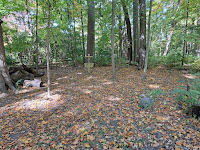














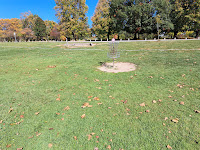






















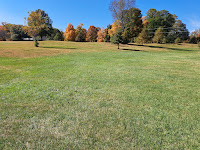


No comments:
Post a Comment